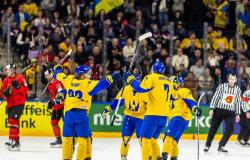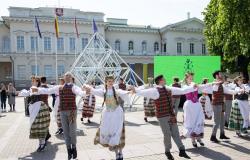
Built more filters
In October of last year, water purification filters were installed in the Lazdininkai well, which were tested in Šilute, and are not used in the rest of the country. “These current next-generation anionite-cationite water filters are the company’s last hope to improve well water quality to meet drinking water requirements.” Laboratory water tests are optimistic – the water is suitable for use”, said Eglė Alonderienė, director of Kretingos Vandenys.
The elder of Lazdininkai, Rima Dobravolskienė, agreed that after the construction of the last water purification filters, which are already in use, the quality of the water improved, but not so much that people decided to use it for food. “The water is disgustingly slippery, you can’t wash your hands, washing dishes slip from your hands. When you turn on the tap, the water is full of bubbles, the smell of chlorine spreads, when you hold the water, those bubbles collapse, the chlorine evaporates,” R. Dobravolskienė described the water. “Kretingos vandenys” supplies 66 households with well water. According to the elderly woman, most residents have installed additional water filters in their homes, but still do not use water for food. “During so many years, it got into people’s minds that that water is not suitable for food, and it is not easy to get rid of that perception. For food, we buy water in small quantities from stores,” said R. Dobravolskienė.
Today, the well water first passes through the salt, the capacity of which is constantly replenished, after which it enters filters that are washed every 3-4 days. “We are still trying to figure out the best mode of operation of the filters. Filters work in automatic mode, they are also washed. We carefully monitor the quality of water in the networks, not only in the watering place. There are older pipelines and sections of the network in the settlement, where the water stagnates, we just flush it,” said E. Alonderienė about efforts to ensure water quality.
Aimed to improve water quality
The Lazdininkų well, the water place, was installed in 2019 by the closed joint-stock company “Eigesa” from Vilnius. The implementation of this project cost 79 thousand. EUR, the funds were received from EU support funds, state and municipal budgets. The borehole is twice as shallow as the previously used 200 m deep borehole of the Soviet era.
“Kretingos vandenys” today has over 20 boreholes in the villages of the district, the water extracted from about 200 m does not meet the requirements set for drinking water. The water of these wells usually contains an excess of fluorine and iron. The water of the old well in Lazdinkai also contained boron, which is harmful to humans, and you cannot taste it. Excess fluoride harms teeth, iron damages household appliances, water is not acceptable for consumption due to its color. The price of installing such a single deep well is about 300 thousand. euros. Fluoridation filters are especially expensive, iron removal is cheaper.
According to the calculation of “Kretinga Waters”, about 5 million is needed to ensure the quality of water in all over 20 water bodies. euros. Fungi and bacteria are very rare in the water of deep wells. Taking water from deeper layers and building expensive equipment for its purification pays off where there are more users, such as in the city of Kretinga. In order for people in the smaller settlements of the district to get quality drinking water, it was chosen to build cheaper, shallower wells from 70 to 100 m deep, whose water is free of excess fluoride, boron, and other harmful impurities typical of deep well water. In the region, such boreholes have already been installed in the settlements of Baubliai, Kurmaičiai, Rūdaičiai and Lazdininkai.
Neringas Šeirys, a geologist of the “Artva” company who explored the region of Western Lithuania and conducted geological research, confirmed that shallower water wells solved the water quality problems in Kurmaičiai, Baubliai, Rūdaičiai – “on the edge”, but in Lazdininkai they got stuck in a mire of unexpected problems.
“The case of Lazdininkai is the first, non-standard, caused by the natural conditions that existed here thousands of years ago. The sliding glaciers, of which there were 4 or 5 on Lithuania – scientists are still debating, in the shallower intermoraine layers of the Lazdininkai settlement in nature’s jar preserved bacteria, fungal spores, which, when the water is brought to the surface and warmed up to +10 °C and more, receive oxygen, come to life, take reproduce,” explained the geologist.
Researchers hired by “Kretinga Vandenő” from the Nature Research Center, who studied the water of the Lazdininkai reservoir, found that the water is dominated by Flavobacterium micromati and Pseudomonas frederiksbergensis bacteria, the dominant fungus is Aspergilys flavus.
In search of clean water in the shallower layers, “Kretingos vandenys” drilled several times to different depths in Lazdininkai, but the results of the water quality obtained during the experiments were not satisfactory.
The company will not overcome the problems alone
According to N. Šeiris, there are probably bacteria and fungal spores in the shallower underground water layers of 70-100 m depth in the territory of the neighboring municipality of Skuodas district. “Perhaps since 2016-2017, it has been said that it should be found out where shallower wells can be drilled according to natural conditions, and where there is no such possibility, it should be decided whether to bring drinking water from the nearest water source or whether it would be cheaper to bring it,” said the geologist, emphasizing that taking into account these exceptional natural conditions in Lithuania, the provision of clean water to the population should be decided at the state level. “The solution in Lazdininkai could also be by laying a water pipe from Darbėnai. “Kretingos vandenys” and the contractor are struggling, the technologies applied throughout Lithuania are not suitable here, because the conditions here in those interlayers are like that, is it worth the trouble”, N. Šeirys thought.
The unfinished project of the Lazdininkai watering place is also a challenge for the contractor – the company “Eigesa”, which specializes in water improvement devices. “During those almost 5 years in Lazdininkai, probably all known and possible water filters, washing networks were tested, in separate periods we brought drinking water to the residents from other water sources, and we tested people’s patience all that time,” said E. Alonderienė about the hopelessness of the situation.
A new phase of EU support for financing regional development projects begins. The intensity of project financing from the EU is 50 percent. New EU support can be expected for settlements with at least 200 inhabitants for water management projects. Among the above-mentioned 20 water bodies in the district, the water bodies of the villages of Juodupėnai, Raguviškių, Šukė, Laukžeme, Klibiai, and Senosios İpilties meet this criterion. E. Alonderienė confirmed that “Kretingos vandenys” is preparing an investment project for supplying the listed settlements with drinking water, but to allocate the other 50%. the company itself is unable to provide the funds needed to implement the investment project. Borrowing limits have thus been finally exhausted during the construction of water supply and sewage networks in “Vienybės” and “Draugystės” gardeners’ associations, in the village of Kluonalii. The director did not deny that the loans have to be repaid from the company’s accumulated funds for amortization, so there are no funds left for rebuilding the existing assets.
“Small water supply companies are left to their own devices. Have fun while you can, you won’t – we will connect you to “Klaipėda water”. The direction of the state water management policy to expand the companies that supply water centrally and manage waste water is becoming more and more obvious”, – shared insights of E. Alonderienė, who has been working in various positions in the water management sector since 1996, has held various management positions in the company “Klaipėdos vanduo”, and has been a member of this company for 4 terms since 2004 member of the company’s board.
Tags: Western Lithuania unusual situation drinking water fight thousands years preserved bacteria fungal spores





